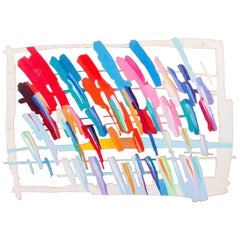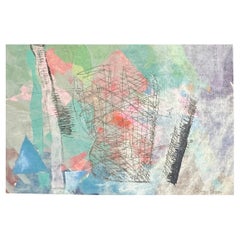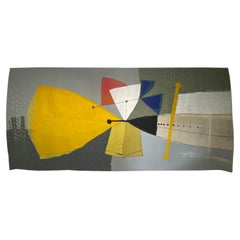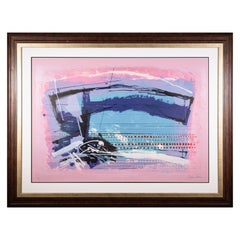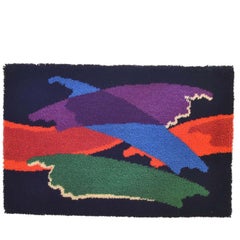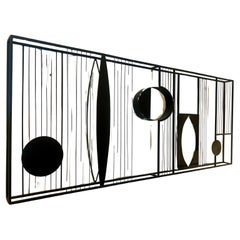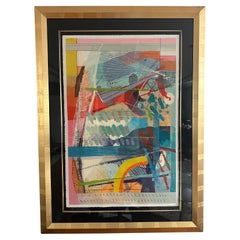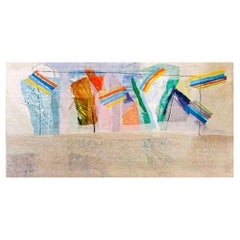Calman Shemi Furniture
Argentinian, b. 1939
Calman Shemi was born in Argentina in 1939. He studied sculpture and ceramics at the School of Mendoza in Argentina. In 1961, Shemi emigrated to Israel, and in 1963 he began studying sculpture with Rudi Lehman. He created his first "soft" paintings in 1977. Since 1978, he has worked primarily in serigraphy and acrylic paintings. In 1999, Shemi developed the "windows" and the "lacquer" painting techniques. The "window" or "shadow box" painting is a unique form of artistic expression. First Shemi creates a painting in a wooden box. After completion of the painting, he affixes a customized wooden frame to the box. This unusual technique results in the illusion of looking through a window to the landscape or into a room. The frame is then covered with silver or gold leaf and finally lacquered. The final result is a piece of art that emphasizes the contrast between the outside level and the painting within a deeper level.
Lacquer paintings are also one of Shemi's original creations. These works usually begin as an exciting abstract design or still-life painted on wood or on a metal panel that has been covered in layers of gold and/or silver leaf. After the paint has dried, the painting is gilded with many layers of lacquer. Between each layer of lacquer the surface is hand polished to give it a metallic finish, resulting in a luminous effect.
Remarkably, artist Shemi has had 71 one-man shows all around the world, including Israel, France, Singapore, Nigeria, Australia, Japan, Canada, Spain Germany, the United States and elsewhere. His works are displayed in the Spertus Museum of Judaica, the Fashion Institute of Chicago, Citibank in New York, the Hebrew University in Jerusalem, just to name a few.to
5
5
2
5
1
4
1
2
3
1
1
1
1
2
2
2
1
1
5
5
5
14
8,701
3,917
2,534
2,229
Creator: Calman Shemi
Calman Shemi Listed Artist Postmodern Abstract Metal Wall Sculpture
By Calman Shemi
Located in Charleston, SC
Calman Shemi (Argentina/Israel, b. 1939), Musical Notes #9, Painted Steel Wall Piece, 1995, signed and numbered 9/9. Provenance: Purchased from Circle Gallery February 29, 1996. Thi...
Category
Late 20th Century Israeli Post-Modern Calman Shemi Furniture
Materials
Metal, Enamel
Calman Shemi Environmental Sculptures Signed Contemporary Modern Wall Tapestry
By Calman Shemi
Located in Keego Harbor, MI
A contemporary modern abstract tapestry titled "Environmental Sculptures" by Argentinian artist Calman Shemi. Hand signed and titled on verso with an annotation of 7/9. Circa 1980s. ...
Category
1980s Unknown Vintage Calman Shemi Furniture
Materials
Tapestry
Large Woven Wool Rug / Wall Art-Tapestry "Essence of Absurd #2" by Calman Shemi
By Calman Shemi
Located in San Diego, CA
Large soft painting woven wool rug / wall art-tapestry "Essence of Absurd #2" by Argentinian-Israeli artist Calman Shemi, circa 1984. This a vibrant and expressive tapestry that sho...
Category
Mid-20th Century Israeli Modern Calman Shemi Furniture
Materials
Textile, Natural Fiber
Calman Shemi Large Format Wall Tapestry, 1978
By Calman Shemi
Located in Miami, FL
Monolithic wool wall tapestry by artist Calman Shemi dated 1978. Can be hung horizontal or vertical.
Calman Shemi
Argentine/ Israeli
1939 -
Tapestry
Signed and dated near lowe...
Category
1970s Argentine Modern Vintage Calman Shemi Furniture
Materials
Wool
Calman Shemi Manuscript 1989 Abstract Modern Signed Lithograph 90/300 Framed
By Calman Shemi
Located in Keego Harbor, MI
An expressive and lively lithograph titled "Manuscript" from artist Calman Shemi. Hand signed in pencil on the bottom right with an annotation of 90/300 on the bottom left. This love...
Category
1980s Vintage Calman Shemi Furniture
Materials
Paper
Related Items
Abstract Vibrant Wall Tapestry by Junghans, 1960's
Located in London, GB
Colorful hand knotted wool hanging is probably a translation of the work of an artist. This was a time when modern artists work began to work with weavers...
Category
1960s German Mid-Century Modern Vintage Calman Shemi Furniture
Materials
Wool
1980's Postmodern Wall Metal Geometric Sculpture
By (after) Frank Lloyd Wright
Located in San Diego, CA
A rare metal wall mounted geometric wall sculpture, 3d style very nice design circa 1980's , in the style of Frank Lloyd Wright , veri nice and unique piece.
Category
20th Century American Post-Modern Calman Shemi Furniture
Materials
Metal
Large « jungle » tapestry
Located in Isle Sur Sorgue, FR
Rare large wool tapestry from the sixties representing a jungle.
Inspired by the douanier Rousseau with tropical birds and plants, it is very decorative.
Great quality and condition.
Category
1960s French Vintage Calman Shemi Furniture
Materials
Wool
Mid Century Modern Abstract Art Lithograph Signed Aki Kimoto
Located in Miami, FL
Original modern art lithograph by Japanese artist Aki Kimoto. This colorful piece bears an original signature and is number 12/150 of the limited edition. Combining cubic images as w...
Category
21st Century and Contemporary Japanese Calman Shemi Furniture
Materials
Paper
$360 Sale Price
20% Off
H 19.1 in W 27.76 in D 0.1 in
Vintage Brutalist Abstract Metal Nail Wall Art Sculpture, circa 1970
By William Bowie, Curtis Jeré
Located in Philadelphia, PA
Vintage Brutalist Abstract Metal Nail Wall Art Sculpture
In the Style of William Bowie, circa 1970's
Artist Unknown
" in very good vintage condit...
Category
1970s American Brutalist Vintage Calman Shemi Furniture
Materials
Metal
Helen Webber Wall Tapestry
By Helen Webber
Located in Fulton, CA
A signed Helen Webber fabric collage wall tapestry. Hand made with various fabrics. Features a stylized horse with a tree and moon.
Signed by artist.
Numbered 15/50
Measures 35 in...
Category
Late 20th Century American Mid-Century Modern Calman Shemi Furniture
Materials
Fabric, Wool
Design Wall Tapestry
Located in Praha, CZ
- 1960s
- Perfect condition.
Category
1960s Mid-Century Modern Vintage Calman Shemi Furniture
Materials
Wool
Bobyrug’s Nice Modern French Tapestry Signed Nee
Located in Saint Ouen, FR
Explore timeless beauty with a midcentury French rug by Pauline Nee. This exquisite creation bears the signature touch of Nee Creation, a French enterprise known for crafting modern ...
Category
Mid-20th Century French Modern Calman Shemi Furniture
Materials
Wool, Cotton
Jazz Band Metal Wall Sculpture
Located in Douglas Manor, NY
1734 Five piece metal jazz band wall sculpture
Category
1970s Vintage Calman Shemi Furniture
Materials
Metal
Woven Wool Tapestry in the Style of Evelyn Ackerman
By Evelyn Ackerman
Located in Kansas City, MO
Beautiful vintage modern wall hanging of an outdoor scene with people, animals, and trees in the styled of Evelyn Ackerman. Very good condi...
Category
1950s American Mid-Century Modern Vintage Calman Shemi Furniture
Materials
Wool
Antique French Tapestry Handmade Tapestry Large Verdure Tapestry 5x9
Located in New York, NY
Antique Tapestry French Figural Tapestry Verdure Battle
5' x 8'10" (5' x 9')
152cm x 269cm
Circa 1900
"This is an Rare Antique French Aubusson Tapestry with monogram signat...
Category
Early 1900s French French Provincial Antique Calman Shemi Furniture
Materials
Wool
$7,800 Sale Price
20% Off
H 105.91 in W 59.85 in D 0.48 in
Large Medieval Style Aubusson Tapestry Wall Hanging
Located in Nottingham, GB
Large Medieval Aubusson Tapestry Wall Hanging, depicting a lady surrounded by a lion and a unicorn.
From a private collection
Free international shipping.
Category
20th Century Calman Shemi Furniture
Materials
Cotton
Previously Available Items
Calman Shemi - Boogie Woogie Screenprint in Colors - Signed and Numbered
By Calman Shemi
Located in Alpha, NJ
This is a beautiful screenprint in colors by Calman Shemi. This work is in very good overall condition with vibrant colors. This is a limited edition and is signed and numbered along...
Category
21st Century and Contemporary Argentine Calman Shemi Furniture
Materials
Paper
Calman Shemi First Light at Dawn Tapestry, 1990
By Calman Shemi
Located in Chicago, IL
Calman Shemi First Light at Dawn Tapestry, Signed 1990's. There is a slight water mark on upper right side.
Calman Shemi uses a great mix of colors, textures and shapes. He also deve...
Category
1990s Argentine Post-Modern Calman Shemi Furniture
Materials
Natural Fiber, Paint
Calman Shemi Abstract Expressionist Tapestry, "Lagoon" #6
By Calman Shemi
Located in Skokie, IL
Calman Shemi Tapestry " Lagoon " #6
A beautiful "soft-painted textile" by Argentinian-Israeli sculptor and painter Calman Shemi (b. 1939). This...
Category
1980s Israeli Expressionist Vintage Calman Shemi Furniture
Materials
Wool, Linen
Contemporary Modern Calman Shemi Still Life Tapestry, circa 1990s
By Calman Shemi
Located in Keego Harbor, MI
A Calman Shemi still life tapestry, circa 1990s. A lovely expressive piece from Argentinian artist Calman Shemi. Shemi is a life long artist who ha...
Category
1990s Calman Shemi Furniture
Materials
Tapestry
Limited Edition 20th Century Calman Shemi "Abstract" Tapestry Rug
By Calman Shemi
Located in San Francisco, CA
Limited Edition 20th Century Calman Shemi "Abstract" Tapestry Rug
Bright, bold and colorful limited edition tapestry by listed artist Calman Shemi
This is number 2 out of 9
...
Category
Late 20th Century American Modern Calman Shemi Furniture
Materials
Textile
Calman Shemi, "Where the Childrens Meet #18" Tapestry Soft Painting
By Calman Shemi
Located in Norwalk, CT
Calman Shemi, Argentinian (b. 1939).
"Where the Childrens Meet" #18. Branded signature lower left-hand corner; hand-signed, titled, and editioned on verso.
This monumental wall tapestry is an expressive example of Calman Shemi's original "Soft Painting...
Category
Late 20th Century Israeli Calman Shemi Furniture
Materials
Fabric, Textile
Contemporary Signed Calman Shemi Soft Sculpture Hanging Wall Tapestry, 1980s
By Calman Shemi
Located in Keego Harbor, MI
For your consideration is a breathtaking, abstract tapestry wall art, made of wool, titled "Flash Fire #5," signed by Calman Shemi, circa 1980s. In excellent condition. The dimension...
Category
1980s Vintage Calman Shemi Furniture
Materials
Wool
H 70 in W 49 in D 0.5 in
Framed Original Abstract Lithograph by Calman Shami Title Spanish Fan
By Calman Shemi
Located in San Diego, CA
A colorful abstract litho by listed artist Calman Shami, circa 1980s framed in white frame unopened nice condition. Edition 290/300; Measures: 35" X 25" without the frame.
Category
Late 20th Century Israeli Post-Modern Calman Shemi Furniture
Materials
Paper
Calman Shemi 74" Wide Abstract Soft Art Wall Hanging
By Calman Shemi
Located in Toledo, OH
A beautiful large (74" wide x 52" tall) abstract wall hanging done by Calman Shemi in brilliant colors with his "soft" art technique circa 1980. Art is mounted to a wood frame.
Calman Shemi developed this soft art...
Category
1980s Israeli Modern Vintage Calman Shemi Furniture
Large Soft Painting by Israeli Artist Calman Shemi
By Calman Shemi
Located in Norwalk, CT
Calman Shemi, sculptor and painter, was born in Argentina in 1939.
In 1961, at the age of 20, Shemi immigrated to Israel. There he worked as a sculptor working with wood and clay. Several of his large-scale fiberglass and polyester projects are situated in public buildings. Though sculpture dominated his early years as an artist, in the mid ’70s Shemi developed the idea of the “soft painting...
Category
1970s Israeli Vintage Calman Shemi Furniture
Materials
Fabric
Calman Shemi furniture for sale on 1stDibs.
Calman Shemi furniture are available for sale on 1stDibs. These distinctive items are frequently made of fabric and are designed with extraordinary care. There are many options to choose from in our collection of Calman Shemi furniture, although brown editions of this piece are particularly popular. Many of the original furniture by Calman Shemi were created in the modern style in south america during the late 20th century. If you’re looking for additional options, many customers also consider furniture by and Hencer Molina. Prices for Calman Shemi furniture can differ depending upon size, time period and other attributes — on 1stDibs, these items begin at $750 and can go as high as $45,000, while a piece like these, on average, fetch $6,300.
